|
Population was one of the major topics the Global Geography 12 students studied.
Its been estimated that there is over
6.4 billion people living on this earth. The population increases about 2.55 people every second, 153 people every minute,
9180 in an hour, 220 320 in a day, and about 80 million +/- with in the next year.
Demography is the gathering and analysis of information about human populations. It considers the numbers
of people, birth and death rates, age and sex ratios, and migration and literacy rates. Recently demography involves any study
of human population, including the size, distribution and growth.
Collecting Information on Population
How do we collect population information? A census form is mailed and/or handed out to every household. It is to be
filled out and returned. It collects such information like age, sex, occupation, monthly income, mortage and rent payments,
education and much more. But census' are not always reliable. Some people refuse to fill them out, and in the less developed
countries, they can't always get a form, so this causes a inaccurate reading.
There are many other reasons why census forms arent filled out. Homelessmess, without a permanent address, the homeless
cannot recieve a form. Although some of the homeless are counted in shelters, most are missed. Fear of entering slums and
crime filled areas, some people are scared to enter these areas, because they are worried they will get hurt or injured.
Isolation, some people are living in areas so far out of reach that the census forms cannot reach them. Confusion,
people not at their usual residence on the census day can be easliy missed. Including college students or people on vacations,
or if they simply are not home to recieve it. Privacy issues, alot of people wish not to fill out the census forms,
although these forms are treated confidential. A lot of the time most questions like monthly income, mortage payments, and
home ownership questions are avoided. Reputation, most of the time the data collected was used to determine tax costs
or the number of men that could be used in the military service. And to this day, people are still suspicious of the census
forms.
Problems Resulting from Inaccuracies
There are several factors affecting inaccuracies.
Unfair political representation, governments used the data collected to resolve political boundries and the number
of elected officials, wrong information could end in unfair representations. Unfair levels of funding, a lot of the
time, the government would use this information to distribute funding to schools that had little to no population records.
Wrong information would result in unfairness. Lack of funding for homeless people, when the homeless people aren't
counted in the census program, it is hard to say how many need shelter and food. Therefore funding is available, but not being
distributed. Product failure, if companies are distributing products to population numbers that may not exist, it can
cause product failure. Faulty economic policies, if population growth data is mistaken, economist can very easily get
the wrong idea about economy growth.
Measuring Population Change
Two things that demographers want to know most is size and rate of change. Size "refers to the actual number of people in
a population at a given time in history." Rate of change "indicated how a population has changed over a period of time."
Absolute population change - is the actual number of people the population has increased and drcreased by in
a certain period of time.
Relative population change - also known as the population growth rate, this measures the average yearly percentage
change over the same time frame. To calculate the population growth rate use the following formula:
Divide the absolute change by the beginning population, then multiply the value by 100 to get the percentage. Once you've
done that, divide the percentage by the number of years over which the population change took place to get an average annual
rate.
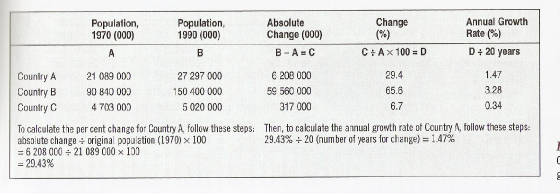
Factors Affecting Population Change
There are four factors affecting population change.
1) Number of people who are born
2) Number of people who die
3) Number of people who move into a country
4) Number of people who leave a country
These four statistics are also called "vital statistics". Demographers use more accurate measures, like fertility rates, replacement
levels, and child and infant mortality rates.
Migration
There are two types or migration:
Immigration, which is the movement of people into a country, and emigration, which is the movement of people
out of a country. Migration is a high population change factor.
Push and Pull forces are forces that help people recognize the causes of migration. A push force is just like a push
factor, it is something that makes a person want to leave a country. Like lack of job, or lack of education. A pull force
is the same as a pull factor, it pulls someone into a country, like clean water, and a excellent education system. For most
countries the pull factors are the influencing roll in society, and other countries the push factors play a significant roll
in their culture.
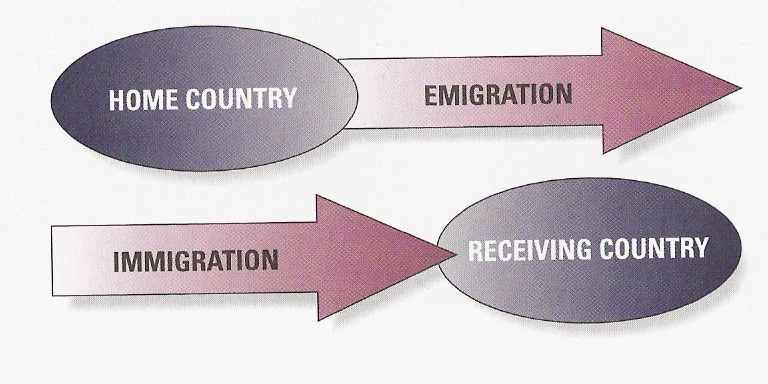
Births and Deaths
The term "fertility" is used to measure births, and "mortality" is used to measure deaths. In 2005, Canada was estimated to
have 10.84 births/1,000 people and 7.73 deaths/1,000 people, and the U.S was estimated to have 14.14 births/1,000 people,
and 8.25 deaths/1,000 people. Birth and death rates are normally calculated on a root of the entire population of a country.
They also have a common term we call "crude rates." Without counting the migrating rate, the yearly rate of a population growth
rate(PGR) equals the birth rate (BR) minus the death rate (DR). This value is called the "rate of natural increase(RNI)."
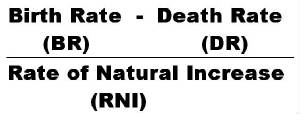
The rate of natural increase, calculated as a rate per 1000, needs to be converted in to percent values.

Factors Affecting Birth Rates
1) Number of women there are in an area
2) The age of a women - child bearing years start at the age of 15, and usually stops at the age of 49.
3) Culture and Religion - some cultures and religions don't allow women to have a child, or more than one child, and
others allow larger families.
4) Medical reasons - some women can't bear children because of conditions like diabetes.
5) Education and economic status - the less education women have can affect the number of children she has. The husband
normally tells the woman how many children she can have if she has little to no education
6) Government population policies - some governments don't have laws regarding fertility.

|
| Average number of births per 1000 people in a year. |
Factors Influencing Death Rates
There are a few factors that affect death rates as well.
1) Availability of medical care - if there is little medical care available, people will die quicker because there
is nothing there to help them live strong.
2) Cost of health care - some people cannot afford good medical coverage.
3) Education - education helps the women keep their childrens health in good condition, as well as their own
4) Availability of food and clean water
5) Level of economic development
6) War and environmental disasters
7) Country's fertility rate - a large number of births can increase the death rate. The more children a woman has,
the bigger the risk of dieing while giving birth.
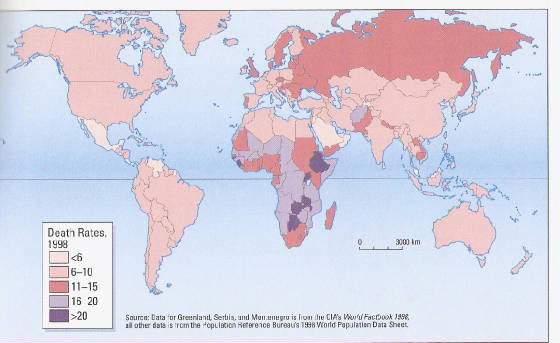
|
| Death rates per country. |
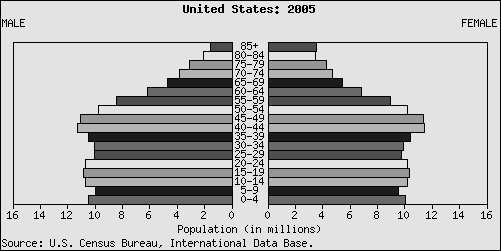
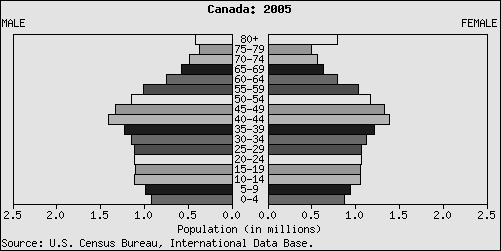
|

